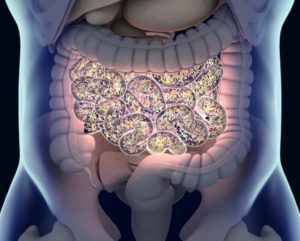The Importance of GI Health: Part One
June 2018 ¦ Megan Kraeger, MSACN- Clinical Nutritionist
The human gastrointestinal (GI) microbiome is comprised of a complex ecosystem of bacteria, fungi, protozoa, other microbes and genes that influences nearly every system in our body. There are over 400 bacterial species in the GI system, (1,2) which is greater than the total number of cells in the human body. (2) We often hear about the negative effects of bad bacteria and microbes, however, bacteria can have many beneficial functions in our bodies. A healthy microbiome is important for the digestion and absorption of nutrients, immune function, production of vitamins and neurotransmitters, and favorable gene expression, among other things.
The microbial ecosystem is influenced by several factors. Colonization of the human microflora starts at birth.1 The route of delivery- vaginal vs. C-section plays a role in the infant’s microbiome composition. Vaginal delivery exposes the infant to beneficial bacterial species that babies born via C-section are not exposed to. (3) Human breastmilk is another important factor in the development of a healthy gut microbiome, as beneficial bacteria are transferred from mother to infant. (1) Antibiotic use significantly influences the composition of bacteria and microbes. While antibiotics can kill bad bacteria that cause infections and disease, they also wipe out good bacteria that are beneficial in our bodies. Broad spectrum antibiotic use can cause an imbalance in bacterial species, leading to a dominance of unfavorable and resistant bacteria. (2) The imbalance of bacteria, termed dysbiosis, is associated with several conditions, including gastrointestinal problems and disorders, autoimmune conditions, and certain types of cancers. (2) Other factors that contribute to dysbiosis include medications such as those for acid reflux, environmental toxins, water contaminants, and chemicals and preservatives in processed foods. (3)
Bacteria are responsible for the production of short-chain fatty acids (SCFA), vitamin K and several B vitamins: thiamin (B1), riboflavin (B2), biotin (B7), and B12. (2) SCFA, such as butyrate are important because they activate immune cells to help maintain a healthy immune system and produce mucous secretions to keep the intestinal lining healthy. (4) Neurotransmitters such as serotonin are also produced by bacteria in the GI tract. (5) Serotonin is involved in the regulation of appetite, sleep, memory and learning, along with other brain functions. (5) These vitamins, neurotransmitters and other substances have many roles in the body, therefore, insufficient amounts can negatively impact different body functions.
Bacteria in the GI tract are also responsible for breaking down food and the absorption of nutrients from food. (6) For example, polyphenols found in fruits and vegetables are involved in protecting cells against damage, but are not well absorbed. Polyphenols need to be broken down by bacteria into intermediates and end products in order to be absorbed and active. (6)
Since about 70% of the immune system is located in the GI tract, immune health is dependent on the health of the gut. (3) Additionally, the intestinal mucosa acts as a protective barrier against unwanted food particles and harmful microorganisms. (3) The immune system is impacted if there is an imbalance in microflora from any of the factors mentioned above or if the mucosal lining of the GI tract is compromised.
Altered GI function is the underlying cause of many conditions that may seem unrelated to gut. (7) Some skin conditions such as eczema, rheumatoid arthritis, migraine headaches, food allergies, childhood ear infection, and several others may all be traced back to the GI system not functioning properly. (7) If the GI tract is unable to produce vitamins and substances it normally does, can’t digest and absorb nutrients from food properly, or can’t activate immune cells to fight off infection, symptoms will occur.
Part 2 of this series will focus on actions you can take to improve your GI health.
- Shokryazdan P, Jahromi MF, Liang JB, Ho YW. Probiotics: From isolation to application. Journal of the American College of Nutrition. 2017; 36(8):666-676.
- Lord RS, Bralley JA. Laboratory Evaluations for Integrative and Functional Medicine. Duluth, Georgia: Genova Diagnostics; 2012.
- Roundtree R. Proven therapeutic benefits of high quality probiotics. Advanced Nutrition Publications. 2002. 1-6.
- Yoon MY, Yoon SS. Disruption of the Gut Ecosystem by Antibiotics. Yonsei Med J. 2018 Jan;59(1):4-12.
- Galland L. The Gut microbiome and the brain. Journal of Medicinal Food. 2014;17(12):1261-1272.
- Edwards CA, Havlik J, Cong W, et al. Polyphenols and health: Interactions between fibre, plant polyphenols and the gut microbiota. Nutrition Bulletin. 2017;42(4):356-360.
- Liska DJ, Lukaczer D. Gut dysfunction and chronic disease: The benefits of applying the 4R GI Restoration Program. Advanced Nutrition Publications. 2001. 1-8

